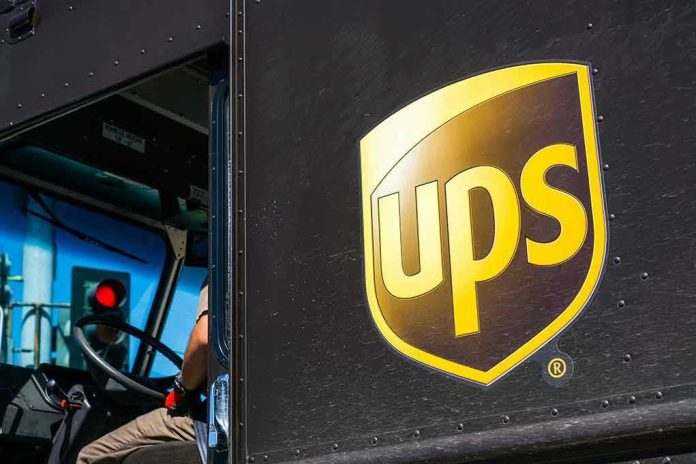
One minute, a UPS cargo plane was cutting through the Kentucky sky; the next, a fireball exploded so fiercely that its shockwave rattled the city’s industrial heart—and the tragedy nearly became a regional catastrophe.
Story Highlights
- A UPS jet crashed just after takeoff from Louisville, causing a massive fireball and nine deaths.
- The left wing caught fire and the engine detached, setting off a chain of explosions across nearby businesses.
- The crash site’s proximity to critical infrastructure magnified the risk and nearly escalated the disaster.
- Federal investigation is underway, probing maintenance protocols and emergency response effectiveness.
Louisville’s Global Hub Turns Into Ground Zero
Louisville’s Muhammad Ali International Airport, usually bustling with the rhythm of commerce, became a scene of chaos at 5:15 p.m. on November 4th, 2025. The UPS plane, freshly loaded and cleared for takeoff, barely left the ground before disaster struck. The left wing caught fire, witnesses reported a shower of sparks, and then the left engine tore away from the fuselage. What had begun as a routine cargo run for one of the world’s largest logistics firms instantly devolved into a nightmare scenario. The jet veered off airport property, slamming into nearby industrial buildings and triggering secondary explosions. The sky was lit with an inferno seen for miles, and the city braced for the worst.
First responders raced in as flames consumed Kentucky Petroleum Recycling and Grade A Auto Parts. Emergency teams confronted not just aviation wreckage but hazardous chemicals, fuel tanks, and the real possibility of further explosions. As debris scattered across a half-mile radius, search and rescue operations stretched into the night. The confirmed death toll climbed to nine, with eleven more suffering injuries so severe that two remained in critical condition by morning. The community held its breath, knowing the Ford factory and convention center were mere blocks away—had the plane veered differently, the scale of destruction might have dwarfed even this tragedy.
Federal Probe Targets Rare Mechanical Failures
The National Transportation Safety Board (NTSB) mobilized within hours, sifting through twisted metal and charred concrete for clues. Early findings centered on the left wing fire and the catastrophic detachment of the engine, a failure so rare that aviation experts immediately called for a sweeping review of cargo aircraft maintenance. Investigators recovered cockpit voice and data recorders, hoping to piece together the final moments before impact. UPS executives faced intense scrutiny, balancing crisis management with the need to reassure employees and the public about safety standards. Louisville’s airport authorities coordinated closely with federal teams, aware that any hint of systemic failure could reverberate across the industry.
The probe’s urgency reflects more than local concern—it’s a signal to the entire logistics sector. Louisville’s Worldport hub is central to UPS’s global operations, and any disruption ripples through supply chains nationwide. Analysts point out that cargo planes operate under different stress and oversight than passenger jets, raising questions about the adequacy of fire detection, suppression systems, and inspection regimes. The NTSB’s preliminary statement, delivered by spokesperson Todd Inman, emphasized the need for answers but stopped short of assigning blame. For families of the victims and those injured, the wait for accountability is agonizing.
Collateral Damage and Community Fallout
Beyond the loss of life, the crash unleashed a cascade of economic and social consequences. Businesses near the impact zone suffered extensive damage, halting operations and triggering worries about hazardous material exposure. The city’s emergency response was tested—and praised—for rapid containment, but officials acknowledged that luck played a role. Governor Andy Beshear’s remarks underscored how close the region came to an even greater disaster: the flight path skirted critical infrastructure by mere yards. Local residents, already grappling with trauma, now face the prospect of long-term disruptions, environmental cleanups, and the specter of future risks.
The ripple effects extend to UPS’s reputation and regulatory landscape. Industry insiders anticipate heightened scrutiny of cargo aircraft safety protocols, not just for UPS but sector-wide. Calls for improved fire suppression and stricter maintenance schedules are gaining momentum. Aviation academics argue for more robust oversight, noting that while passenger flights receive intense regulatory attention, cargo operations can fall through the cracks. The Louisville crash is likely to fuel legislative proposals and possibly reshape emergency response standards for airports surrounded by high-risk facilities.
Expert Analysis and the Road Ahead
Aviation safety experts stress the extraordinary nature of engine detachment—a mechanical failure that should be virtually impossible given current engineering and inspection practices. Some point to the need for culture change in cargo aviation, advocating for transparency and technological upgrades. Others caution against premature conclusions until the full investigation is complete. What’s clear is that the Louisville tragedy has shattered complacency, igniting debate about risk management and public safety in the age of global logistics. The story isn’t just about one crash; it’s about how a single mechanical failure exposed vulnerabilities that could affect communities across America.
As the NTSB continues its work and the community mourns, the open questions linger: Will federal investigators uncover flaws that demand industry-wide reform? Can UPS and other cargo carriers rebuild trust with employees and the public? The answers will shape not just the aftermath in Kentucky, but the future of air freight safety and the resilience of the nation’s supply chain.
Sources:
ABC7 News: UPS plane crash explosion leaves 9 dead, others missing in Kentucky









